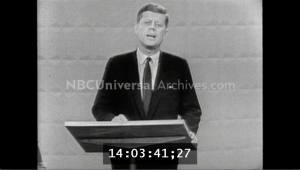“Edward R. Murrow – See It Now (March 9, 1954).” YouTube video, 2:02. Posted by “Justin Hillyard,” August 22, 2009.
On this episode of See It Now, aired in March of 1954, host Edward R. Murrow reports on the controversial Republican Senator Joseph McCarthy. In the report, Murrow uses McCarthy’s own words to demonstrate how McCarthy’s actions were a danger to American democracy. McCarthy had been leading congressional investigations to find communist sympathizers in the U.S. government, academia, and the entertainment industry. McCarthy would accuse individuals of being communists spying on the U.S. with no proof. Murrow and his team knew that airing this report would make them an enemy of McCarthy. This broadcast is an example of the press holding a member of congress accountable for abusing his power. The broadcast also is an example of the news media shaping the public’s political opinions since it helped turn the public against McCarthy’s tactics.
Kennedy, John F. and Richard Nixon. “John F Kennedy and Richard Nixon at the 1960 presidential debate.” NBC News Archives video, 0:31. September 26, 1960.
In this NBC broadcast, 1960 presidential candidates, John F. Kennedy and Richard Nixon, participate in the first televised presidential debate. The debate was broadcast on both television and radio. The campaign was primarily focused on national security and Cold War issues, with both candidates having very similar positions. Following the debate, those listening on the radio believed that the debate had been a draw or that Nixon had won. However, television viewers overwhelmingly believed that Kennedy was the better candidate. Some have speculated that because Nixon was exhausted from campaigning and recovering from the flu, he was no match visually to Kennedy, who was well rested, tanned, and wearing stage makeup. The impact of this television broadcast on this presidential election, reflects the previously unrecognized power of this new medium to impact the perception of the American voting public.
“Vietnam War, 1970: CBS camera rolls as platoon comes under fire.” YouTube video, 5:08. Posted by “CBS Evening News,” April 30, 2015.
In this Vietnam War era CBS News television report, correspondent Richard Threlkeld is embedded with a platoon of GI’s on patrol in the Vietnamese jungle. His reporting includes descriptions of a few of the GI’s, as well as their goals and aspirations following the war. As the platoon completes it surveillance mission and begins to head back to their meeting point, they come under fire. One GI is wounded in both legs and must be evacuated by helicopter. The Vietnamese enemy is nowhere to be found. Threlkeld ends his report capturing the frustration that is the Vietnam War. He describes soldiers’ heroism, the feeling of danger and fear, but also no clear vision of a path to victory.This reporting gave Americans back home an inside look at the war on the ground, what the soldiers go through daily, and also the frustration that winning the war may not be an option. This contributed to the public’s understanding and eventual turn against the war.

